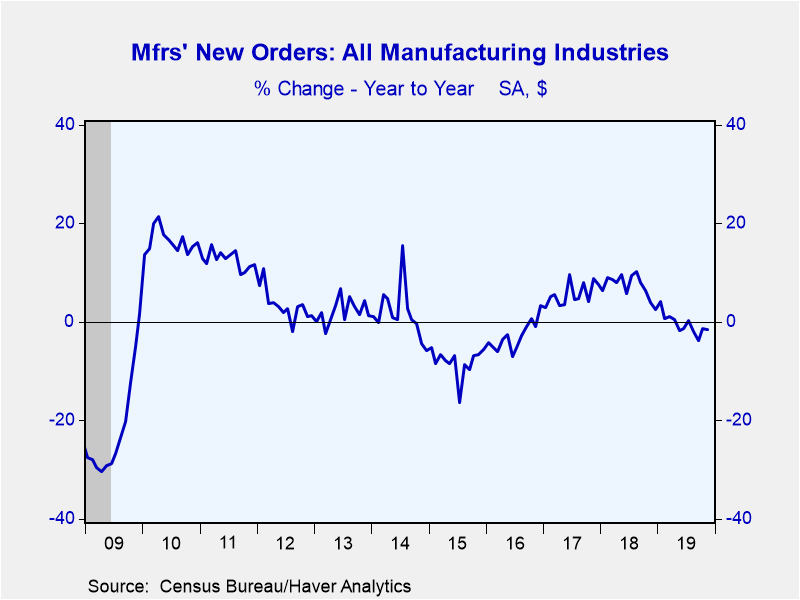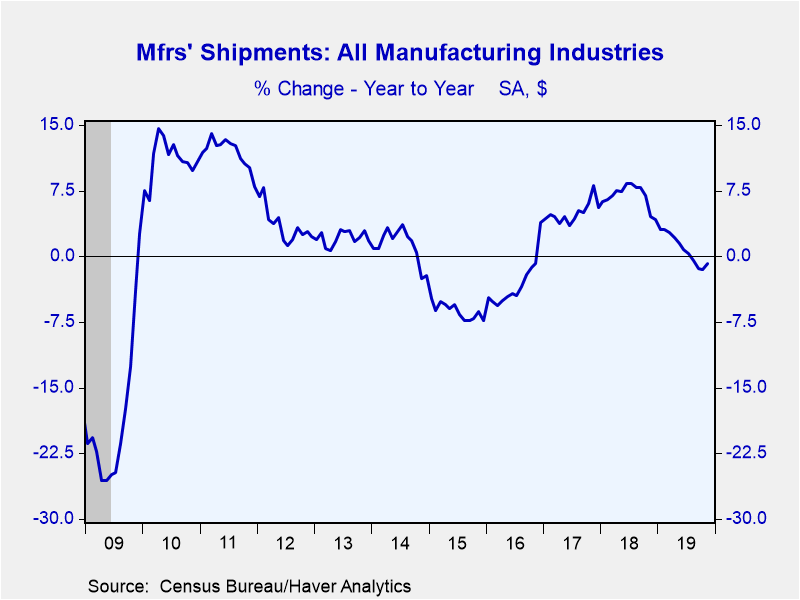 Global| Jan 07 2020
Global| Jan 07 2020U.S. Factory Orders Slump in November
by:Sandy Batten
|in:Economy in Brief
Summary
Factory orders decreased 0.7% m/m (-1.5% y/y) in November following a slightly downwardly revised 0.2% m/m increase in October (initially reported as +0.3% m/m). This was the third monthly decline in the past four months. The November [...]
Factory orders decreased 0.7% m/m (-1.5% y/y) in November following a slightly downwardly revised 0.2% m/m increase in October (initially reported as +0.3% m/m). This was the third monthly decline in the past four months. The November weakness had been generally expected after the advance report on durable goods orders released previously, which showed a 2.0% m/m decline in those orders. The Action Economics Forecast Survey had looked for a 0.8% m/m decline in total orders in November. The initially reported 2.0% m/m decline in orders for durable goods was revised down slightly to -2.1% m/m. A 35.5% m/m plunge in orders for aircraft was a leading factor behind the November decline in both factory and durables goods orders. Total orders excluding transportation were up 0.3% m/m in November, led by increases in orders for electrical equipment (+2.0% m/m), furniture (+1.0% m/m) and nondurable goods (the new information in this report, which rose 0.6% m/m).
Total shipments rose 0.3% m/m (-0.8% y/y) in November following a modest 0.1% m/m increase in October, which followed three consecutive monthly declines. Shipments of durable goods were unchanged in November while shipments of nondurable goods (which equals orders) rose a solid 0.6% m/m (0.9% y/y) on top of a 0.3% m/m rise in October. However, the November increase was not widely spread, but rather was concentrated in a 2.7% m/m increase in orders for petroleum products that accounted for 88% of the increase in nondurable shipments/orders. Shipments fell in six of the ten major categories.
Unfilled orders in the factory sector fell 0.4% m/m (-2.0% y/y) in November after having been unchanged in October. All unfilled orders are for durable goods. Almost all of the November decline in overall unfilled orders was due a 0.6% m/m drop in unfilled transportation orders (largely unfilled defense aircraft orders, -2.6% m/m).
Total factory inventories increased 0.3% m/m (+2.7% y/y) in November for the third consecutive monthly increase. Inventories of durable goods rose 0.4% m/m while inventories of nondurable goods edged up 0.1% m/m. This was the fifteenth consecutive monthly increase in durable goods inventories. The November increase in durables inventories was led by a 1.9% m/m jump in inventories of nondefense aircraft and parts. November nondurables inventories was dominated by a 2.2% increase in inventories at petroleum refineries.
The factory sector figures are available in Haver's USECON database. The expectation figure is in the AS1REPNA database.
| Factory Sector (% chg) - NAICS Classification | Nov | Oct | Sep | Nov Y/Y | 2018 | 2017 | 2016 |
|---|---|---|---|---|---|---|---|
| New Orders | -0.7 | 0.2 | -0.8 | -1.5 | 7.3 | 5.7 | -2.9 |
| Shipments | 0.3 | 0.1 | -0.4 | -0.8 | 6.9 | 5.0 | -3.2 |
| Unfilled Orders | -0.4 | 0.0 | 0.0 | -2.0 | 3.9 | 1.9 | -1.1 |
| Inventories | 0.3 | 0.2 | 0.3 | 2.7 | 3.5 | 4.5 | -0.7 |
Sandy Batten
AuthorMore in Author Profile »Sandy Batten has more than 30 years of experience analyzing industrial economies and financial markets and a wide range of experience across the financial services sector, government, and academia. Before joining Haver Analytics, Sandy was a Vice President and Senior Economist at Citibank; Senior Credit Market Analyst at CDC Investment Management, Managing Director at Bear Stearns, and Executive Director at JPMorgan. In 2008, Sandy was named the most accurate US forecaster by the National Association for Business Economics. He is a member of the New York Forecasters Club, NABE, and the American Economic Association. Prior to his time in the financial services sector, Sandy was a Research Officer at the Federal Reserve Bank of St. Louis, Senior Staff Economist on the President’s Council of Economic Advisors, Deputy Assistant Secretary for Economic Policy at the US Treasury, and Economist at the International Monetary Fund. Sandy has taught economics at St. Louis University, Denison University, and Muskingun College. He has published numerous peer-reviewed articles in a wide range of academic publications. He has a B.A. in economics from the University of Richmond and a M.A. and Ph.D. in economics from The Ohio State University.










